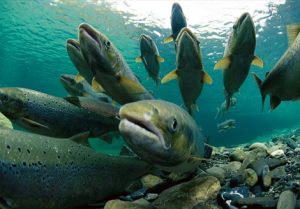
Five years ago, marine biologists at the University of North Carolina at Chapel Hill proposed a theory that sea turtles and salmon use the Earth’s magnetic forces to find their way back to their birthplace after migrating across thousands of miles of open, featureless sea. Now, those same researchers have found a way to test that theory in salmon – and found it to be true.
“This is the first direct evidence supporting the geomagnetic imprinting hypothesis,” said Kenneth Lohmann, who co-led the study with Nathan Putman, who is currently at Oregon State University. “Before, it was just an idea.”
In 2008, Lohmann proposed that when marine animals such as sea turtles begin life, they learn or “imprint” on the magnetic field of their birthplace and later use this information to find their way back home when it is time for them to reproduce. The hypothesis provided the first plausible explanation – a unifying theory – for how marine animals can navigate to their birth areas from distant ocean locations.
To test the hypothesis, Lohmann and Putnam examined more than 50 years of fisheries data on sockeye salmon born in the Fraser River, which lies off the coast of Vancouver, British Columbia. Sockeye salmon from the Fraser River typically spend two years at sea, distributed widely throughout the Gulf of Alaska, before heading back to their birthplace to spawn.
Salmon in the open sea cannot reach the Fraser River by swimming directly to it because Vancouver Island blocks the way. Thus, to reach their spawning area, fish must take one of two indirect routes. One is a narrow channel with its entrance north of Vancouver Island, while the other is a passageway with an entrance south of the island.
The entrances to the north and south routes are far enough apart that the magnetic fields at each location differ considerably. And because the Earth’s magnetic field changes gradually over time, in some years the north entrance is a closer magnetic match to the mouth of the river while in other years the south entrance is a better match.
“The unusual geography around Vancouver Island provided us with a unique opportunity to test this hypothesis,” said Lohmann, who is Charles P. Postelle Jr. Distinguished Professor of biology in the College of Arts and Sciences. “If the geomagnetic imprinting hypothesis is true, then salmon should choose their return route based on how closely the field at each entryway resembles the field that the salmon experienced when they left the Fraser River.”
The fisheries data confirmed this prediction. In some years, most of the salmon took the north route, while in other years they opted for the southern route. Each year, the preferred route was the one that had the magnetic field most similar to that at the mouth of the Fraser River. By remembering the unique “magnetic address” of their birthplace, the salmon apparently navigated from the open sea back to their spawning grounds, choosing the route that best matched their memory.
The idea that salmon have a “magnetic map” in their brain is intriguing, said Lohmann, and it suggests that magnetism may be an important navigational landmark not only for salmon, but also for other creatures like sea turtles and birds that return to home areas after long migrations.
The work appears in the Feb. 7 issue of Current Biology.



